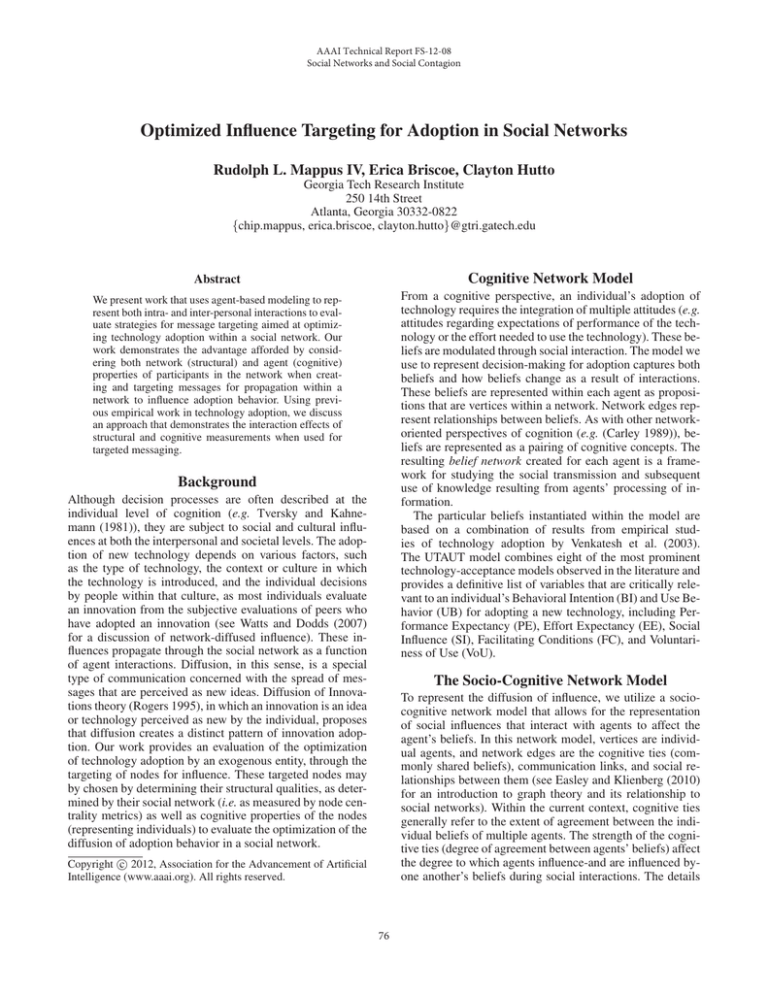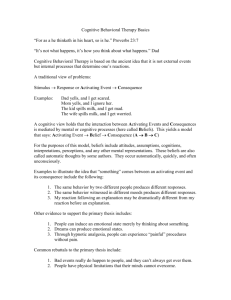
AAAI Technical Report FS-12-08
Social Networks and Social Contagion
Optimized Influence Targeting for Adoption in Social Networks
Rudolph L. Mappus IV, Erica Briscoe, Clayton Hutto
Georgia Tech Research Institute
250 14th Street
Atlanta, Georgia 30332-0822
{chip.mappus, erica.briscoe, clayton.hutto}@gtri.gatech.edu
Abstract
Cognitive Network Model
We present work that uses agent-based modeling to represent both intra- and inter-personal interactions to evaluate strategies for message targeting aimed at optimizing technology adoption within a social network. Our
work demonstrates the advantage afforded by considering both network (structural) and agent (cognitive)
properties of participants in the network when creating and targeting messages for propagation within a
network to influence adoption behavior. Using previous empirical work in technology adoption, we discuss
an approach that demonstrates the interaction effects of
structural and cognitive measurements when used for
targeted messaging.
From a cognitive perspective, an individual’s adoption of
technology requires the integration of multiple attitudes (e.g.
attitudes regarding expectations of performance of the technology or the effort needed to use the technology). These beliefs are modulated through social interaction. The model we
use to represent decision-making for adoption captures both
beliefs and how beliefs change as a result of interactions.
These beliefs are represented within each agent as propositions that are vertices within a network. Network edges represent relationships between beliefs. As with other networkoriented perspectives of cognition (e.g. (Carley 1989)), beliefs are represented as a pairing of cognitive concepts. The
resulting belief network created for each agent is a framework for studying the social transmission and subsequent
use of knowledge resulting from agents’ processing of information.
The particular beliefs instantiated within the model are
based on a combination of results from empirical studies of technology adoption by Venkatesh et al. (2003).
The UTAUT model combines eight of the most prominent
technology-acceptance models observed in the literature and
provides a definitive list of variables that are critically relevant to an individual’s Behavioral Intention (BI) and Use Behavior (UB) for adopting a new technology, including Performance Expectancy (PE), Effort Expectancy (EE), Social
Influence (SI), Facilitating Conditions (FC), and Voluntariness of Use (VoU).
Background
Although decision processes are often described at the
individual level of cognition (e.g. Tversky and Kahnemann (1981)), they are subject to social and cultural influences at both the interpersonal and societal levels. The adoption of new technology depends on various factors, such
as the type of technology, the context or culture in which
the technology is introduced, and the individual decisions
by people within that culture, as most individuals evaluate
an innovation from the subjective evaluations of peers who
have adopted an innovation (see Watts and Dodds (2007)
for a discussion of network-diffused influence). These influences propagate through the social network as a function
of agent interactions. Diffusion, in this sense, is a special
type of communication concerned with the spread of messages that are perceived as new ideas. Diffusion of Innovations theory (Rogers 1995), in which an innovation is an idea
or technology perceived as new by the individual, proposes
that diffusion creates a distinct pattern of innovation adoption. Our work provides an evaluation of the optimization
of technology adoption by an exogenous entity, through the
targeting of nodes for influence. These targeted nodes may
by chosen by determining their structural qualities, as determined by their social network (i.e. as measured by node centrality metrics) as well as cognitive properties of the nodes
(representing individuals) to evaluate the optimization of the
diffusion of adoption behavior in a social network.
The Socio-Cognitive Network Model
To represent the diffusion of influence, we utilize a sociocognitive network model that allows for the representation
of social influences that interact with agents to affect the
agent’s beliefs. In this network model, vertices are individual agents, and network edges are the cognitive ties (commonly shared beliefs), communication links, and social relationships between them (see Easley and Klienberg (2010)
for an introduction to graph theory and its relationship to
social networks). Within the current context, cognitive ties
generally refer to the extent of agreement between the individual beliefs of multiple agents. The strength of the cognitive ties (degree of agreement between agents’ beliefs) affect
the degree to which agents influence-and are influenced byone another’s beliefs during social interactions. The details
c 2012, Association for the Advancement of Artificial
Copyright Intelligence (www.aaai.org). All rights reserved.
76
regarding specific cognitive mechanisms and social factors
utilized in the socio-cognitive network model are described
further in (Briscoe, Trewhitt, and Hutto 2011).
optimal diffusion strategies. Our immediate objectives involve proving that under novel interaction models, influence diffusion is approximately optimal (Kempe, Klienberg,
and Tardos 2003). Our future work investigates determining these cognitive properties of nodes from open sources
(e.g. Twitter) and using it along with structural information
found in social networks to provide better prediction of information dissemination in social media.
Analysis and Conclusion
Our aim is to understand how to minimize costs associated with exogenous inputs (e.g. marketing) to maximize
adoption diffusion within a networked population. To evaluate the advantage afforded by utilizing both structural and
cognitive characteristics, we create an agent-based model
(see Bonabeau (2002) for a description of agent models) implemented in the Repast framework (North et al. 2007). We
simulate the social interaction for an agent population over a
discrete time period (600 timesteps), where communication
networks are created using a ’small world’ approach (Watts
and Strogatz 1998).
By comparing overall adoption rates (dependent variable)
across our simulated population (200 agents), we determine that the rate from targeting nodes based purely on
structural properties (as done, for example, by Kiss and
Bichler (2008)) is significantly less than the rate obtained
when targeting using the combined heuristic. Our analysis
uses node degree as the unit structural property (see Borgatti (2005) for determining appropriate centrality measures
for attitude propagation) and the similarity of beliefs between a node and its neighbors as the cognitive property.
Figure 1 shows the results of a simple experiment aimed at
demonstrating the improvement. In this experiment, nodes
were ranked by their centrality (structural), then by their belief overlap with their neighbors (cognitive). Highest ranked
nodes were selected by centrality in the centrality-alone case
and by centrality and belief overlap in the combined case.
A t-test shows the statistical significance of the difference:
(p < 0.006).
Our results show that utilizing even coarse approximations of the cognitive properties of nodes, such as belief
overlap (which we propose as related to cognitive centrality
- a measurable concept that represents an agent’s belief overlap with those in his communication network - see Kameda,
Ohtsubo, and Takezawa (1997) for more detail) can change
References
Bonabeau, E. 2002. Agent-based modeling: methods and
techniques for simulating human systems. Proceedings of
the National Academy of Sciences 99(3):7280–7287.
Borgatti, S. 2005. Centrality and newtork flow. Social Networks 27:55–71.
Briscoe, E.; Trewhitt, E.; and Hutto, C. 2011. Closing the
micro-macro divide in modeling technology adoption. In
Proceedings of the Second Annual Conference of the Computational Social Science Society of America.
Carley, K. 1989. The value of cognitive foundations for
dynamic social theory. Journal of Mathematical Sociology
14:171–208.
Easley, D., and Klienberg, J. 2010. Networks, Crowds,
and Markets: Reasoning About a Highly Connected World.
Cambridge, MA: Cambridge University Press.
Kameda, T.; Ohtsubo, Y.; and Takezawa, M. 1997. Centrality in sociocognitive networks and social influence: an
illustration in a group decision-making context. Journal of
Personality and Social Psychology 73:296–309.
Kempe, D.; Klienberg, J.; and Tardos, E. 2003. Maximizing
the spread of influence through a social network. In Proceedings of the Ninth International Conference on Knowledge Discovery and Data Mining, 137–146. ACM Press.
Kiss, C., and Bichler, M. 2008. Indentification of influencers: Measuring influence in customer networks. Decision
Support Systems 46(1):233–253.
North, M.; Tatara, E.; Collier, N.; and Ozik, J. 2007. Visual agent-based model development with repast simphony.
In Proceedings of Agent Conference on Complex Interaction and Social Emergence. Argonne National Laboratory,
Argonne, IL.
Rogers, E. 1995. Diffusion of innovations. New York: Free
Press, fourth edition.
Tversky, A., and Kahnemann, D. 1981. Modeling the
framing decisions and the psychology of choice. Science
211(4481):453–458.
Venkatesh, V.; Morris, M.; Davis, G.; and Davis, F. 2003.
User acceptance of information technology: toward a unified
view. MIS Quarterly 27:425–478.
Watts, D., and Dodds, P. 2007. Networks, influence, and
public opinion formation. Journal of Consumer Research
34:441–458.
Watts, D., and Strogatz, S. 1998. Collective dynamics of
’small-world’ networks. Nature 393(6684):409–410.
120
100
Mean Adoption
80
60
40
20
0
Centrality
SCIP + Centrality
Target Selection Basis
Figure 1: Mean adoption for centrality alone heuristic (left)
and combined cognitive/centrality heuristic (right) over 20
simulations. Error bars show the standard error of the mean.
77






